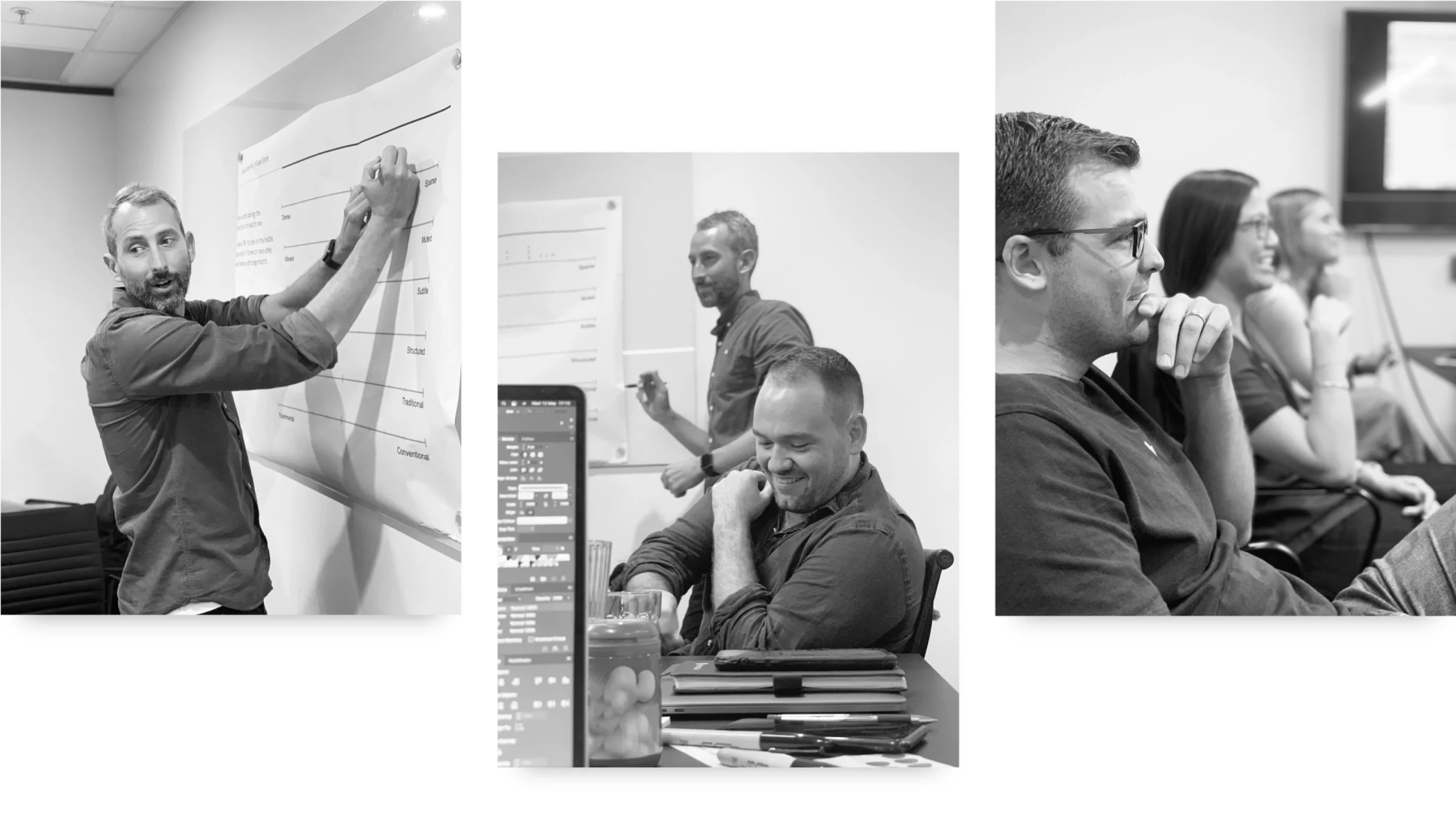(A professional services rebrand survival guide)
Mergers in professional services aren't just about bigger teams, better office views, and the revenue pot growing. They're about people navigating change while trying to keep the wheels turning. And unlike tech startups or product brands, the stakes are often higher because the business is built on trust, not transactions.
So, how do you bring two professional service brands together without making it feel like one side "won"? How do you honour long-standing relationships while carving out a bold, united future?
Here's what we've learnt about rebranding in the pro services world and, more importantly, how to survive it!
Forget the Logo. Can You Survive a Monday Together?
When two professional services firms come together, it's not just about unifying names or swapping out logos. It's about merging how you think, how you work, and how you show up day to day. And that bit? It gets real, real fast.
You quickly discover that it's not just about aligning values, it's about reconciling how decisions get made, how clients get serviced, and how teams collaborate. One firm might be used to fast-and-loose execution, the other might be meticulous to the point of paralysis. One has a flat structure, and the other has a hierarchy and dotted lines.
Suddenly, you're not just colleagues. You're in each other's calendars, inboxes, and workflows. And without shared ways of working, things can get murky—fast.
But here's the thing: when you do figure it out, it's magic.
Done right, the merger can become a supercharger. A chance to level up your operational rhythm, your internal culture, and the kind of service you offer to clients. You bring the best of both worlds together and build something stronger.
So before you think about building a brand system, you need to think about;
How do we want to work together?
What does "great service" look like now?
What processes are we adopting, adapting, or ditching?
Where do we actually need to get aligned?
This is the unsexy stuff that makes the sexy stuff (like brand and reputation) stick. Because if your team is clashing behind the scenes, no amount of strategic messaging can hide the cracks.
In short: align the humans first, then the brand.
This is your moment to reset the story
Rebrands don't come around often. Once a decade, if that. A merger? Maybe once in 20 years. This isn't just a refresh, it's a rare, powerful opportunity to reposition.
When two brands come together, it should signal more than just a bigger business. It's a chance to reset the story. To make a statement about who you are now, what you stand for, and where you're heading.
That means you need to ask the big questions:
What market are we playing in now?
What problems are we solving (and for who)?
What do we want to be famous for?
You don't answer those questions over email. This is where you need to get the big thinkers in the same room, literally or virtually, and have the real conversations. Not surface-level alignment, but genuine, strategic focus.
That's where workshops come in. Usually run with a brand strategy partner like Ply, these sessions are designed to pull the thinking out of people's heads and into a shared direction. It's part therapy, part strategy, and part boxing ring in the best possible way.

Who's in the room?
You want key perspectives and interests represented, including:
CEO / Managing Director – for leadership vision and market ambition
Sales leaders – who know what actually converts
Marketing team – the people who'll live and breathe the brand
Client service / account leads – the ones on the frontline with customers
Operations / delivery heads – to keep things practical
And sometimes, a founding partner or board rep if the legacy story really matters
These aren't passive invitees. They're active contributors. The goal isn't consensus. It's clarity. And sometimes, that means healthy disagreement before the alignment clicks into place.
Why does positioning matter so much?
Because in professional services, you often sell the invisible. Your product is your expertise, your people, your approach. If you can't clearly articulate what makes you different or valuable, you risk sounding like every other brand out there.
Great positioning sharpens your marketing, guides your sales team, attracts the right clients, and gives your people a reason to be proud of the logo on the door. It's the spine of your brand.
So no, this isn't just a workshop tick-box. It's the strategy that everything else hangs off. And if you're already going through the upheaval of a merger, you might as well do it properly.
This is your one big chance to reposition with purpose. Don't waste it.
From sharp positioning comes standout branding
Alright, you've done the hard yards. You've got the team aligned. You've figured out what this new merger stands for. Now it's time to launch this out into the world.
This is where it all starts to feel real. The rebrand moves from a big, messy idea into something you can see, hear and click on. Something your team can get behind. Something your clients can feel.
Because let's be honest — if you're merging and your brand still looks like it did five years ago, what's the point?
It's more than a logo swap
What you're creating now is a whole brand identity system. Not just a new logo and some colours, but all the elements that set the brand up to stand out.
That includes:
A logo that signals the shift
Colours and fonts that feel fresh but not foreign
A visual style that ties everything together
A tone of voice that sounds like real people talking, not robots reading a white paper
Messaging that actually explains who you are and why it matters
A website that's not just pretty, but purposeful
All the day-to-day stuff — proposals, slides, footers, signage — that adds up to real consistency
This is the gear that makes the brand feel solid. Familiar, but new.
The strategy in action
Every part of your new brand should link back to your positioning. This isn't about looking new, it's about clearly showing the shift, that you're not just bigger, you're better.
When your identity, tone and messaging all pull in the same direction, people get it. Clients feel more confident. Your team feels more aligned. And your marketing finally starts to sound like it came from the same planet.
Some numbers for the sceptics
If you need something to back all this up in a boardroom slide:
Brands that show up consistently are 3 to 4x more likely to be remembered
60% of merger rebrands work better when there's a proper internal rollout
77% of B2B leaders say brand is critical to driving growth
(Stats courtesy of Lucidpress, B2B International, McKinsey. Thanks legends.)
Say it clearly, say it often
A big part of making the brand feel real is what you say and how you say it. Your messaging is what turns strategy into something your team can actually use and your clients can actually understand.
It helps you explain the merger without the waffle. It makes the new direction feel purposeful. And it gives everyone the language to tell the story the same way, whether they're in sales, delivery, or running the front desk.
And don't forget your own people
One last thing? Don't build the brand for the outside world and forget the people inside it.
Your team is going through just as much change as your clients. A great rebrand should help them feel excited and proud to be part of something new. That means involving them early, sharing the thinking, and giving them the tools to bring the brand to life in their own way.
Don't just merge, transform
Mergers are messy. Rebrands can be too. But when you treat them as a genuine chance to rethink who you are and where you're headed, they become a reset. A rallying point. A chance to build something more future-fit than what came before it.
So, take the time to get the people aligned. Make the effort to nail the strategy. Then build a brand that brings it all to life.
